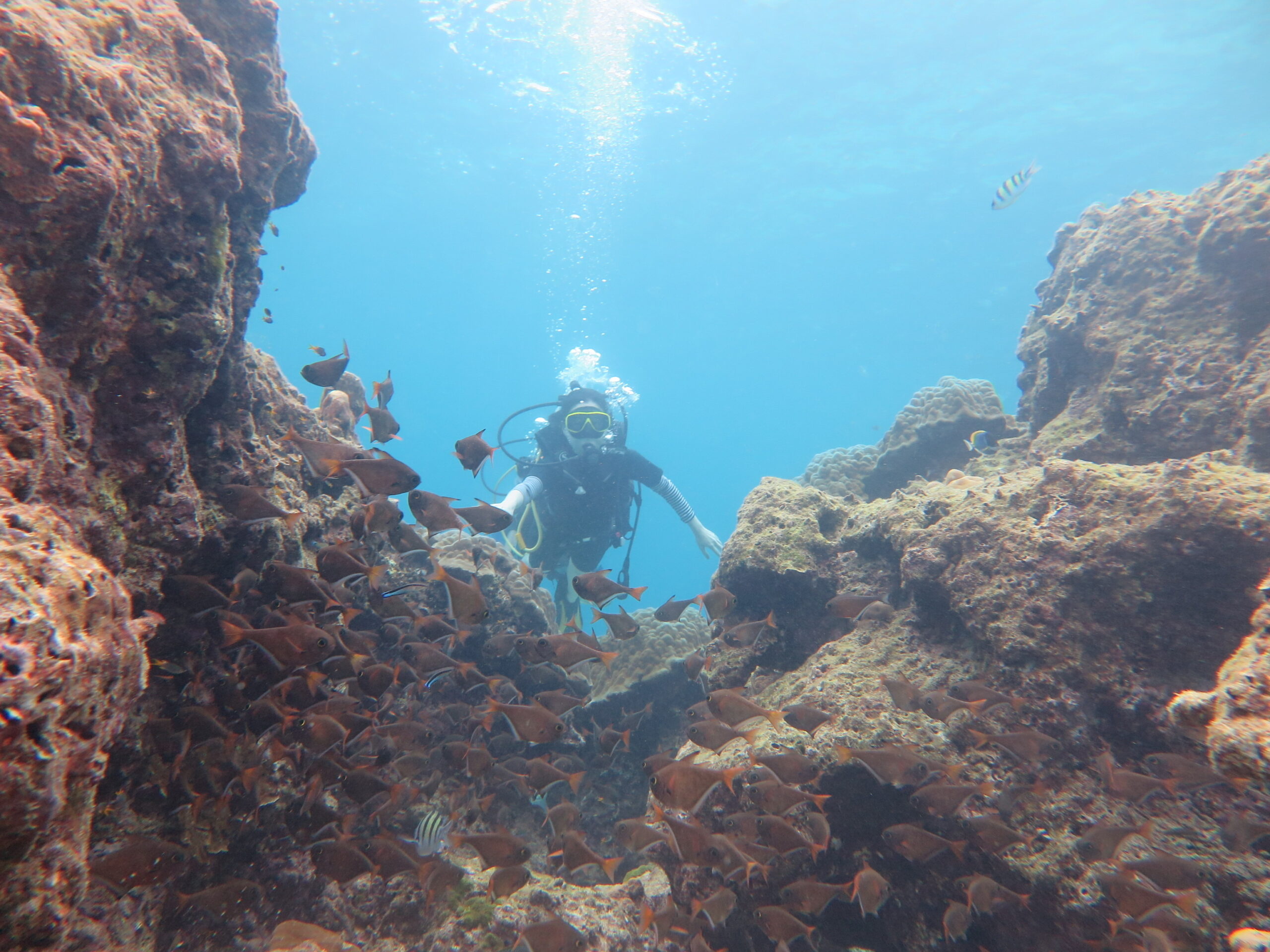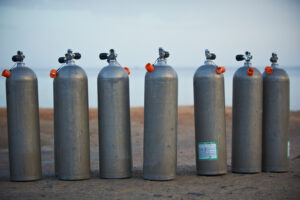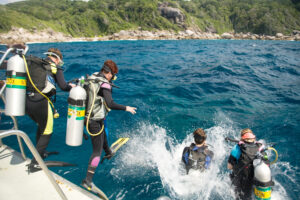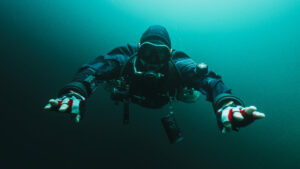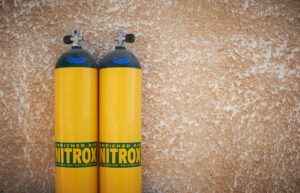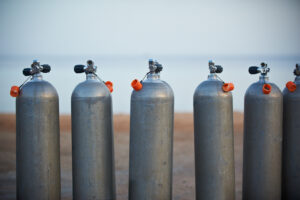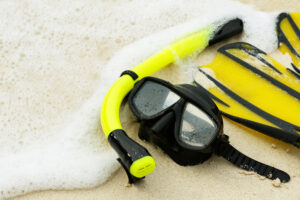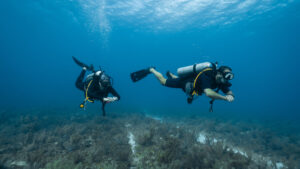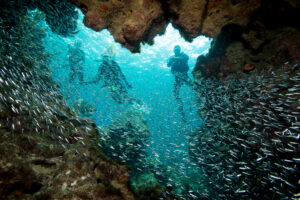What is Wall Diving?
Wall diving is a mesmerizing and unique form of scuba diving, where enthusiasts descend alongside vertical geological formations, typically in locations where the ocean floor abruptly falls away into deep water. These formations, often cliffs, rock walls, or coral reefs, run vertically, extending from shallow to significant depths. Wall diving offers divers the unique opportunity to explore a dramatically different underwater environment, offering a vast array of marine life and breathtaking views.
Formation and Types of Dive Walls
Wall diving locations are formed primarily through geological and biological processes. Some wall dives are along the edge of continental shelves where the seafloor abruptly drops off. Others form on the periphery of volcanic islands where the landscape steeply descends into the ocean. Wall diving may also occur along vertical coral reefs, these biological structures can form walls over thousands of years of growth and deposition.
The type of wall encountered during diving can vary significantly, from sheer cliffs to sloping terrains that may have overhangs or caves. The compositions differ as well, from coral-encrusted walls to rocky surfaces or walls covered in soft corals and sponges. Each type of wall provides a unique habitat for a diverse array of marine organisms, contributing to the richness of the experience.
Marine Life and Ecosystems
Wall diving provides a window into a richly diverse marine ecosystem. Many wall diving sites are renowned for their abundant and varied marine life. Coral walls serve as habitats for a spectrum of organisms, from colorful reef fishes to crustaceans, mollusks, and various types of corals. In contrast, rocky wall environments might host various species of starfish, anemones, and barnacles, along with larger species like octopuses and eels.
On deeper parts of the wall, divers may encounter pelagic or open ocean species such as sharks, rays, or schools of tuna. Some wall diving sites are also frequented by sea turtles, dolphins, or even whales. The walls serve not only as homes for various creatures but also as hunting grounds and migratory paths, offering divers a unique perspective on marine life behaviors.
Techniques and Safety Considerations
While wall diving can be incredibly rewarding, it also requires specific techniques and considerations for safe and enjoyable dives. First, divers must have excellent buoyancy control. Since the wall extends to significant depths, maintaining the correct depth and avoiding an unplanned descent is crucial.
Divers should also be aware of the possibility of ‘depth vertigo,’ a disorientating sensation caused by the vast open water space and the lack of a visible bottom. Training and experience can help divers manage this phenomenon effectively.
Equipment checks are essential in wall diving. Due to the potential for rapid depth changes, dive computers are indispensable for monitoring depth and no-decompression limits. Safety equipment like surface marker buoys (SMBs) are also important in the event of an emergency ascent.
Environmental Considerations and Conservation
As with all types of scuba diving, environmental consideration is paramount in wall diving. Divers must maintain good buoyancy control to avoid damaging delicate coral and other marine life on the wall. It’s also crucial to not remove any marine life or artifacts from their natural environment.
Many wall diving sites are located within Marine Protected Areas (MPAs) or other conservation areas, where rules and regulations are in place to protect the marine ecosystems. These might include restrictions on touching or disturbing wildlife, collecting souvenirs, or using certain types of equipment. Adherence to these rules not only helps preserve the environment for future generations but also ensures the continued health and diversity of the marine life that makes wall diving so special.
Equipment and Training
In addition to standard scuba gear, wall divers may also use specialized equipment. For instance, a dive light is useful for looking into crevices or caves along the wall. Underwater cameras or video equipment are also common, allowing divers to capture the stunning views and unique marine life encounters.
Training for wall diving usually involves advanced buoyancy control techniques and navigation skills, along with specific safety procedures for deep diving. Many diving organizations offer wall diving specialty courses, where divers can learn and practice these skills under the guidance of experienced instructors.
Popular Wall Diving Locations
Wall diving opportunities are found worldwide, with some locations renowned for their exceptional diving conditions and unique marine life. In the Caribbean, the Cayman Islands are famous for their wall diving, with the North Wall of Grand Cayman being a standout site. The Great Barrier Reef in Australia offers Ribbon Reefs, a series of ten individual reefs that provide excellent wall diving opportunities.
In Asia, the Tubbataha Reefs Natural Park in the Philippines is a UNESCO World Heritage site with spectacular wall diving. In Europe, the Blue Hole in Gozo, Malta, is a unique wall diving experience, offering a blend of geological formations and abundant marine life.
Wall diving is an exciting branch of scuba diving that offers a unique perspective on the underwater world. From the breathtaking views of vertical cliffs descending into the deep to the bustling marine life that inhabits these walls, wall diving is a bucket list item for many divers. With the proper training, equipment, and respect for the environment, it’s an adventure that combines thrill, beauty, and an enriching learning experience. Whether it’s the vibrant walls of a coral reef or the rugged rock faces of a deep-sea cliff, the world of wall diving awaits with experiences as diverse as the walls themselves.

